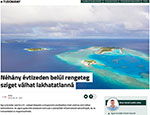This study is a collaboration between the U.S. Geological Survey (USGS), the National Oceanographic and Atmospheric Administration (NOAA), Deltares (an applied research institute in the Netherlands), and the University of Hawaii (UH). The goals of this study are to:
Read more in Overview.

Media coverage of threat to atoll islands from rising seas and wave-driven flooding
A deluge of media coverage followed publication of a USGS-led study showing that sea-level rise and wave-driven flooding could make many low-lying atoll islands uninhabitable by the mid-21st century by contaminating freshwater aquifers and damaging infrastructure.

Many Low-Lying Atoll Islands Will Be Uninhabitable by Mid-21st Century
Sea-level rise and wave-driven flooding will negatively impact freshwater resources on many low-lying atoll islands in such a way that many could be uninhabitable in just a few decades.
Read the April 25, 2018 USGS News Release

Sea-level rise and wave-driven flooding could introduce saltwater so frequently into atoll islands’ freshwater resources that many will be uninhabitable by the mid-21st century, according to a new study published in Science Advances.

USGS research in the Republic of the Marshall Islands forms part of the scientific foundation of an interactive documentary released April 6 by PBS Frontline.
View
“The Last Generation.”

Pacific Missile Tracking Site Could Be Unusable in 20 Years Due to Climate Change
Living and working on the Pacific islands hosting a key missile tracking site soon could be almost impossible due to the impacts of climate change.
See all news stories
Recommended citation: Laura Zink Torresan, and Curt D. Storlazzi, 2014, “The Impact of Sea-Level Rise and Climate Change on Department of Defense Installations on Atolls in the Pacific Ocean”, US Geological Survey, Pacific Coastal and Marine Science Center, doi:10.5066/F7QR4V4C